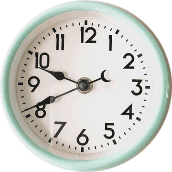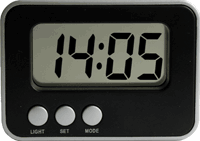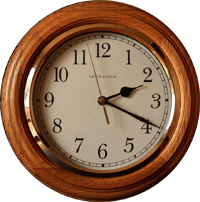Time
Time is a familiar concept to everybody, yet very hard to define. Some scientists define time to be the progress of events that occur in an irreversible succession from the past, through the present, and into the future. There are also many philosphical discussions of time, but those will not be mentioned here.
Time is one of the seven fundamental physical quantities in the International System of Units (SI), which can be used to define other physical quantities, such as speed. In everyday life, time is commonly measured in units of seconds, minutes, hours, days, weeks, months, and years, among others.
24-hour vs 12-hour clock
There are many different ways to measure and read time. Both analog and digital clocks are still very common today. Analog and digital clocks can be further differentiated into 24-hour or 12-hour clocks. Digital clocks can usually display both 24 and 12 hour clocks, while most analog clocks use 12-hour clocks (though analog clocks can also display both). Analog clocks also commonly use Roman numerals in place of Arabic numerals (the numeral system used in most of the world today).


The difference between a 24 and 12-hour clock is simply that, assuming we have a 12-hour clock, the hours only count from 1 up to 12, then repeat again starting at 1. Because of this, for a 12-hour clock, we need to write "AM" (before midday) or "PM" (after midday) after the time to be able to know whether the time is 10 in the morning (10:00 AM) or 10 at night (10:00 PM).
A 24-hour clock removes the need for an AM and PM designation, since the hours count from 0 up to 23 with 0 being midnight and 23 being 11 PM.
To convert the time from a 24-clock to that of a 12-hour clock, just subtract 12 if the hour number is greater than 12, and write "PM." If the hour on the 24-hour clock is smaller than 12, then write the same time along with an "AM." If the hour on the 24-hour clock is 12, then write the same time along with a "PM." The exception is midnight (12:00 AM on the 12-hour clock). Midnight is written as 00:00 on the 24-hour clock. For example:
| 24-hour clock | hour conversion | 12-hour clock |
|---|---|---|
| 0:19 | 0 to 12 | 12:19 AM |
| 1:23 | same | 1:23 AM |
| 11:15 | same | 11:15 AM |
| 12:20 | same | 12:20 PM |
| 13:00 | 13 - 12 = 1 | 1:00 PM |
| 17:45 | 17 - 12 = 5 | 5:45 PM |
| 22:12 | 22 - 12 = 10 | 10:12 PM |
How to read an analog clock
Though many of us may be used to reading a digital clock, it can be useful to be able to read an analog clock in case a digital clock is not available.

The twelve numerals and the large tick marks written on the clock above represent the hours, 1-12. There are 60 marks in total to represent the 60 minutes in an hour and 60 seconds in a minute.
There are normally two or three "hands" on an analog clock. When there are only two hands, the longer hand indicates what minute it is and the shorter hand indicates what hour it is. When there is a third hand (usually the longest but not necessarily), this hand indicates the second. If the length of the hand is difficult to differentiate from the minute hand, note that the second hand will be moving every second, much faster than the minute or hour hand. The design of the second hand is also often different from that of the minute and hour hands, which typically have the same design.
The terms clockwise and counterclockwise come from the direction that the hands on a clock move over time. When the clock hand rotates in the direction of:
- 12 → 1 - this direction is called clockwise
- 12 → 11 - this direction is called counterclockwise
So, to tell time on an analog clock:
- Identify the hour by looking at the shortest hand - you should always read the hour as the numeral that is at or before (with reference to the hour hand moving clockwise) the hour hand. If the hour hand is between 4 and 5, the hour is 4.
- Identify the minute - 0 minutes starts at the top of the clock, at the large tick for 12. Each large tick represents an increment of 5 minutes; the large tick for 1 represents 5 minutes, 2 represents 10 minutes, 3 represents 15 minutes, and so on. The first small tick after the large tick representing 12 is the first minute (and second), 1. The second tick after that is 2, and so on in increments of 1 up through 60.
- If we have a third hand, we can identify the second the same way as we would identify the minute.
So the clock above reads:
2:18:57 AM or 2:18:57 PM
On a 24-hour clock this would be:
02:18:57 or 14:18:57
